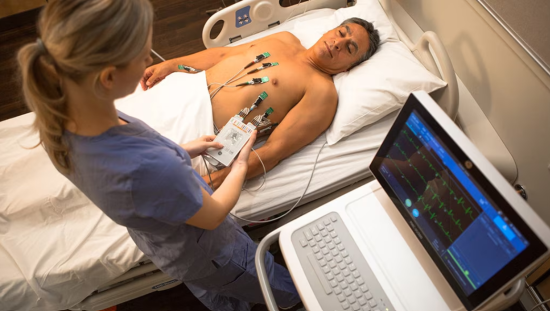Anesthesia providers and hospitals are committed to quality care, but face mounting challenges:
- Workforce shortages and burnout
- Financial pressures
- Environmental sustainability concerns
Expanding surgery volumes amid a workforce crisis
Anesthesia providers are already overburdened, burnout is rampant,[1] and persistent staffing shortages are all further adding to their workloads as hospitals prepare to address increased volumes in the operating room (OR).[2]
- 13% Increase in inpatient surgeries. [2]
- 78% Anesthesia staffing shortages at healthcare facilities. [3]
- 63% Emotional exhaustion among anesthesiologists. [1]
“Growing imbalance in the supply versus demand for anesthesia care providers [...] and increasing complexity of procedures continues to strain resources.” —American Society of Anesthesiologists (ASA)[3]
Augmenting anesthesia teams to manage expanding surgery volumes
The ASA proposes the following:[3]
- Using emerging technologies and AI. Using automation and solutions for augmenting clinical and technical skills aids decision making and efficient care delivery.
- Expanding anesthesia coverage capacity through practice innovations.
- Taking steps to enhance staff retention and address burnout
Compounding the workforce strain: new financial pressures
- 5.1% rise in hospital costs amid flat revenues.[4]
- 70% Hospital margin attributable to the OR.[5]
- 60% U.S. hospitals with OR profit margins less than 0%.[6]
“Nowhere in the hospital is the drive for cost containment and increased patient volume more evident than in the operating theatre. Long-term improvements must embrace radical reduction in OR costs and increased operative patient throughput [...] The ultimate goal of safe and high-quality patient care must not be compromised.” —International Journal of Surgery[7]
How anesthesia providers can help address financial pressures
- Lung protective ventilation techniques and lung recruitment maneuvers: reduce postoperative pulmonary complications[8] and associated costs.
- Quantitative neuromuscular monitoring can help to avoid postoperative complications, such as residual weakness.[9]
- Implementing intraoperative protocols can reduce postoperative complications to drive financial benefits: The cost savings can be attributable to higher patient throughput, reducing LOS and avoiding readmissions.[10]
Growing pressures to reduce emissions and waste without compromising patient care
Anesthesia providers have opportunities to decease their hospital’s greenhouse gas emissions and to drive economic advantages by implementing low flow anesthesia protocols.*
- 25% Anesthetic gas waste in OR.[11]
- 70% Hospital waste comes from greenhouse gas emissions. [12]
- 3-6 times OR generates more carbon than average health system.[12]
How anesthesiologists can help overcome environmental sustainability challenges
- Adoption of low flow anesthesia practices and protocols
- Automation of low flow anesthesia
“Adoption of low-flow anesthesia will be a key lever in helping reduce emissions and lead to cost savings. Automating anesthesia [gas delivery] takes care of a task and in doing so it frees up your mental workload to focus on everything else.” — David Hovord, MB BChir, clinical assistant professor and a lead for University of Michigan’s Green Anesthesia Initiative[13]**
Opportunity to advance quality and patient care
- Care quality: Intraoperative patient monitoring for prehabilitation and postoperative recovery could streamline administrative tasks to reduce workload and cognitive burden.[14]
- Patient safety: Intraoperative lung protective protocols can reduce post-operative pulmonary complications,[15] length of stay, and hospital costs.[16]
- Environmental sustainability: Low flow anesthesia can decrease greenhouse gas emissions by as much as 64%, according to one study.[17]
How technology is a catalyst to simplify low flow anesthesia, lung protective ventilation, and continuous monitoring to overcome the following challenges:
- Workforce shortages and burnout Digital solutions can simplify workflows and may help alleviate the burden of manual tasks so providers can focus on delivering high-quality care.
- Financial pressures Practicing anesthesia in ways that optimize patient care may drive economic advantages by helping to ensure fewer complications during surgery and post-operative recovery.
- Environmental sustainability concerns Automating inhaled anesthetics may reduce agent use, waste, and greenhouse gas emissions aimed at improving environmental sustainability
*Refer to the anesthetic agent labeling for information regarding indications for use, warnings, and other relevant clinical information specific to that anesthetic agent. Any decisions regarding selection of anesthetic agent and flow rate should be made at the discretion of the clinician and their medical judgment based on available information. **Dr. Hovord is a paid consultant for GE HealthCare. His statement is based on his own opinion on results that were achieved in his unique setting. Since there is no “typical” hospital/clinical setting and many variables exist, i.e. hospital size, case mix, staff expertise, etc. there can be no guarantee that others will achieve the same results.
References:
- US attending anesthesiologist burnout in the post-pandemic era, Anesthesiology https://pmc.ncbi.nlm.nih.gov/ articles/PMC10751072/
- 2024 Impact of change forecast highlights, Sg2 Health Care Intelligence https://vizientinc-delivery. sitecorecontenthub.cloud/api/public/content/47212a11b76244d2b3bc7f0e0db086e5
- Anesthesia workforce shortage poses threat to healthcare, American Society of Anesthesiologists https://www. asahq.org/about-asa/newsroom/news-releases/2024/06/anesthesia-workforce-shortage-poses-threat-to-health-care
- The cost of caring: Challenges hospitals face in 2025, American Hospital Association https://www.aha.org/costsofcaring
- 3 ways hospitals need to pivo their OR strategy in the wake of COVID-19, Healthcare Financial Management Association https://www.hfma.org/cost-effectiveness-of-health/financial-sustainability/3-ways-hospitals-need-topivot-their-or-strategy-in-the-wake-of/
- A look at hospital operating margins in the United States, Definitive Healthcare https://www.definitivehc.com/ resources/healthcare-insights/hospital-operating-margins-united-states
- Optimizing your operating room: Or, why large, traditional hospitals don’t work, International Journal of Surgery https://www.sciencedirect.com/science/article/pii/S1743919110000804
- Perioperative lung-protective ventilation strategy reduces postoperative pulmonary complications in patients undergoing thoracic and major abdominal surgery, Korean Journal of Anesthesiology https://ekja.org/journal/view. php?doi=10.4097/kjae.2016.69.1.3
- Advancements in quantitative neuromuscular monitoring, Anesthesia Patient Safety Foundation https://www.apsf. org/article/advancements-in-quantitative-neuromuscular-monitoring/
- ERAS protocols: are they right for every surgery? Clinical View, GE HealthCare https://clinicalview.gehealthcare.com/ article/eras-protocols-are-they-right-every-surgery
- An audit of potentially recyclable waste from anesthetic practice, Anesthesia and Intensive Care https://oce.ovid. com/article/00000522-200937050-00020
- Operating rooms are the climate change contributor no one is talking about, American Association for the Advancement of Science https://www.eurekalert.org/news-releases/951971
- Research interview that Sage Growth Partners conducted on behalf of GE HealthCare in February 2024.
- Unlocking opportunities to transform patient care: an expert insight on limitations and opportunities in patient monitoring, Intensive Care Medicine Experimental https://icm-experimental.springeropen.com/articles/10.1186/ s40635-025-00733-z
- Lung-protective ventilation for the surgical patient: international expert panel-based consensus recommendations, British Journal of Anaesthesia https://www.bjanaesthesia.org/article/S0007-0912(19)30647-6/fulltext
- Lung protective ventilation and associated outcomes and costs for patients receiving invasive mechanical ventilation in the ED, CHEST Journal https://journal.chestnet.org/article/S0012-3692(20)34522-0/abstract
- The anesthesiologist and global climate change: an ethical obligation to act, Current Opinion in Anesthesiology https://journals.lww.com/co-anesthesiology/abstract/2020/08000/the_anes… change__an.18.aspx








